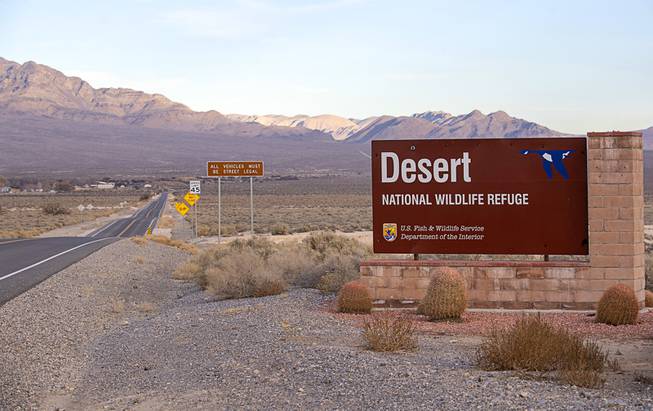
A monument sign on Corn Creek Road marks the entrance to the Desert National Wildlife Refuge north of Las Vegas Friday, Dec. 13, 2019.
Tuesday, Aug. 18, 2020 | 2 a.m.
View more of the Sun's opinion section
Editor’s note: As he does every August, Brian Greenspun is turning over his Where I Stand column to others. Today’s guest is Patrick Donnelly, the Nevada political director of the Center for Biological Diversity Action Fund.
Nevadans have a proud tradition of cherishing our public lands and their spectacular wildlife, and fighting like hell to preserve them.
Efforts to save Desert National Wildlife Refuge from the Air Force’s proposed takeover provide the latest example. Together with our Democratic members of Congress, refuge supporters recently won a huge battle and the refuge is safe for now.
But the fight’s not over yet.
Nevada voters can do their part to make sure the refuge and all of Nevada’s public lands are held in trust for generations to come. We need more environmental champions in Congress — like Democratic Reps. Steven Horsford, Dina Titus and Susie Lee — people who won’t cave into outlandish military demands or corporate polluters.
The 1.6 million-acre Desert National Wildlife Refuge is the largest refuge in the lower 48 states. Its pristine Mojave Desert habitat is home to Nevada’s state mammal, the desert bighorn sheep, and the threatened Mojave desert tortoise. It is visible from the Las Vegas Strip, and many Southern Nevadans consider the refuge their backyard.
But the Air Force wants to expand its Nevada Test and Training Range and take control of 1.1 million acres of the Desert Refuge in what would be one of the most massive land grabs in Nevada history.
Nevadans have spent years pushing back against this land seizure. The broad coalition that first came together to save the Desert Refuge remains strong because of its diversity.
Tribal members from the Moapa and Las Vegas bands of Paiutes play a key role. The Southern Paiute call the Desert Refuge their ancestral lands. The area is full of cultural sites, petroglyphs and notable historically used caves.
Conservation groups, veterans’ groups, sportsmen’s groups and outdoor businesses, including Patagonia, in addition to citizen activists, have worked to save the Desert Refuge, under the banner of #DontBombTheBighorn.
The Desert Refuge campaign also benefited from the heat of the Nevada presidential primary race.
Starting with Sen. Elizabeth Warren, one candidate after another weighed in opposing the Air Force’s bombing range expansion. Julian Castro wrote an op-ed in the Las Vegas Sun saying the expansion plan “tramples on Nevada and Native Americans.”
And in the 2019 Nevada Legislature, state Sen. Melanie Scheible and Assemblywoman Lesley Cohen ushered through a resolution opposing the proposed expansion, which passed with a stunningly bipartisan 58-3 vote.
In December of last year, Sen. Catherine Cortez Masto and the rest of Nevada’s congressional delegation introduced legislation to block all but a small portion of the military’s expansion request. They took a bold stance, laying down a marker showing which side of the issue they were on and clearly reflecting the will of their constituents.
But just last month Utah Rep. Rob Bishop sponsored an amendment to the National Defense Authorization Act to transfer control of 850,000 acres of the Desert Refuge — an area the size of Rhode Island — to the Air Force. The amendment was put forward without consulting or even notifying Nevada’s congressional delegation.
Within days, tens of thousands of letters and phone calls poured into Congress opposing the amendment. The opinion pages, including in this paper, were flooded with op-eds and editorials opposing the Bishop amendment. Social media lit up as people expressed concern and outrage at this land grab.
Nevadans were heard in Washington.
Reps. Horsford, Titus and Lee quickly introduced an amendment to strip the bombing range expansion out of the bill. It passed through the House and the Senate, and the Desert Refuge was left intact.
But it’s not a done deal.
The NDAA now moves to conference committee. Before the end of the year, representatives of the Senate and House Armed Services committees will negotiate a compromise between the two versions of the bill. They are free to change and add language as they see fit.
Nevadans need to remain vigilant and continue to provide our elected leaders all the support they need to represent our interests in Washington.
There’s been talk of shoehorning more legislation into the NDAA, potentially a bill earmarking public lands outside the Las Vegas Valley for sale to developers. Our representatives should save the discussion about future land use in southern Nevada for another day.
As we head toward November, Nevadans must carefully examine the priorities of the people on the ballot. Will the people they vote for do everything in their power to stand up for our public lands and wildlife, like Reps. Horsford, Titus, and Lee did?
We can save the Desert Refuge. We’re almost there. Nevada voters can get us across the finish line by making the right choices this November.
